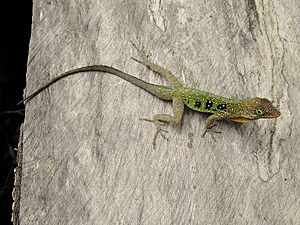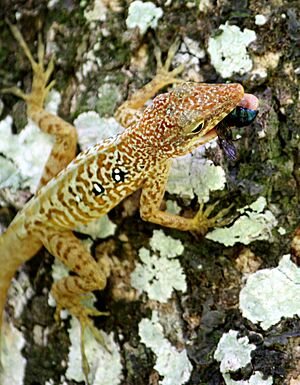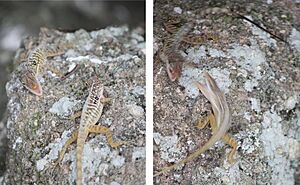Dominica anole facts for kids
Quick facts for kids Dominica anole |
|
|---|---|
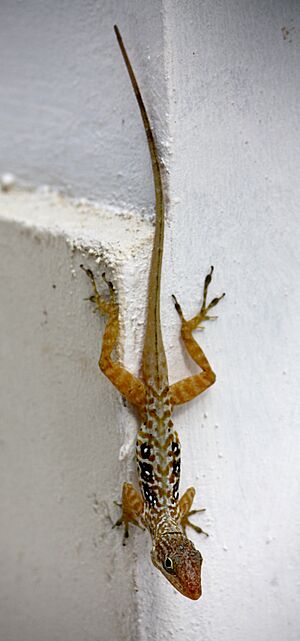 |
|
| A male Dominican anole in its typical perching position. North Caribbean ecotype. Coulibistrie, Dominica | |
| Conservation status | |
| Scientific classification | |
| Genus: |
Anolis
|
| Species: |
oculatus
|
 |
|
| Endemic to Dominica in the Lesser Antilles, a chain of islands in the Caribbean. | |
| Synonyms | |
|
|
The Anolis oculatus, also known as the Dominica anole, Dominican anole, eyed anole, or zandoli, is a type of anole lizard. It lives only on the Caribbean island of Dominica. You can find it in almost every environment there. This lizard comes in many different colors and patterns. Scientists once thought these color forms were different subspecies. However, most other scientists disagreed because the forms gradually blend into each other.
Later, researchers suggested the idea of "ecotypes." They believe the different colors are caused by the environment around the lizard. This is true even though the lizards are genetically very similar. Some of their body features change gradually across the island. For example, they might change from one side of the island to the other, or from sea level to the hilltops. Their main body color can be light tan, yellow, deep green, or brown. They also have patterns like light speckles or marbled designs. Some even have large black-ringed "eye" spots on their sides.
Dominican anoles spend a lot of time in trees but mostly hunt on the ground. They mainly eat small insects. Softer insects and tiny vertebrates are eaten less often. These anoles live a long time and mature later than other anoles. They can usually start breeding when they are about two to three months old. Females lay eggs, and they can breed at any time of year. They usually lay one or sometimes two eggs under rocks or leaves on the ground. The Dominican anole is common on Dominica. However, some experts worried in 2007 that it might face competition from another anole. This other anole, Anolis cristatellus from Puerto Rico, was brought to Dominica a few years earlier.
Contents
What is the Dominican Anole?
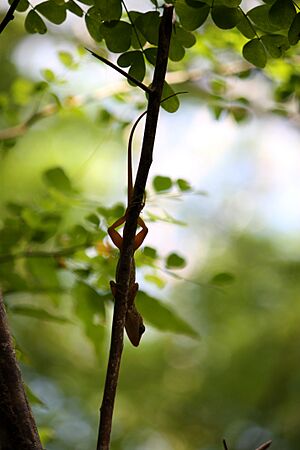
The Dominican anole is known locally as the zandoli, which means "tree lizard." The native Island Caribs believed that having this lizard in their home was a sign of "good spirits."
This lizard is a medium-sized anole. Males can be about 61 to 98 millimeters (2.4 to 3.9 inches) long from snout to vent. Their tails are at least as long as their bodies. Females are smaller than males in all areas. Adult males have a small crest on their tail. They also have a large, colorful throat fan called a dewlap, which is often bright yellow or orange. Females have a much smaller and less colorful dewlap. Some anoles might even have bright blue eyes! Dominican anoles can change their color a little bit, but not as much as some other anole species.
Their main body color can be light tan, ash gray, deep brown, or green. Their markings also vary a lot. Adult males usually have white or light spots all over their bodies. These spots can be small and even, groups of white scales, or streaks that look like marble. Males in some areas also have larger spots on their sides. These spots are ringed by black splotches. Females and young anoles have much lighter or less clear markings. Black spots are very rare on them. Females and young lizards might also have stripes on their sides or down their backs.
Scientists have studied why these anoles are so varied. Their body features change independently. This means that having one feature does not mean they will have another. Some features change with altitude (how high up they live). Others change with longitude (how far east or west they live). They can also be linked to things like rainfall and plant types. Lizards in drier places tend to be paler with marbled patterns. Those in wetter places are a deeper green. This is why scientists use the term "ecotype."
Different Types of Anoles (Ecotypes)
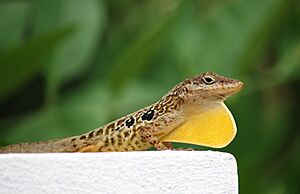
- North Caribbean Ecotype: This type lives in the driest part of Dominica. This is on the northwest, Caribbean coast, in low, scrubby woodlands. They can have the most complex markings. They have bold, light spots that form irregular stripes or marbled patterns. Males often have clear black splotches on their sides. Their main color is gray or pale yellow-brown. Sometimes their head area is darker, even reddish.
- South Caribbean Ecotype: This type is found on the south and southwest coast. It is the smallest and palest in color and markings. It has a light tan to yellow body color. Its white spots are usually not very clear. Dark splotches on the sides are hard to see or missing. This type is currently facing a threat from an invasive species.
- Montane Ecotype: This type lives in the high-elevation rainforest in central Dominica. It has a deep green body color. This helps it blend in with the mossy tree trunks where it mostly lives. They have small, bluish-white spots. Males sometimes have black-ringed spots on their sides, like the north Caribbean type. This group includes the largest anoles.
- Atlantic Ecotype: This type is found along most of Dominica's Atlantic (east) coast. This area is wetter than the west coast. It is medium-sized. It usually has an orange to chocolate brown body color. It has small, scattered white spots, similar to the montane type.
Where Do They Live?
The Dominican anole lives only on the island of Dominica. Dominica is special because it has kept its original reptiles and amphibians for over 200 years. The Dominican anole is one of two lizard species that live only on Dominica. The other is the Dominican ground lizard. It is the only native anole species on the island. You can find it in all habitats and areas up to about 900 meters (2,950 feet) high. It is usually very common. However, it is disappearing from the southwestern coastal area. This is because of an invasive anole species. The coastal woodlands of Dominica are especially good for reptiles. They have one of the highest numbers of reptiles per area ever recorded.
What Do They Eat?
Dominican anoles live partly in trees but mostly hunt for food on the ground. Their diet is mainly insects. However, what they eat changes depending on their habitat and the season. It also depends on the size of the lizard. They might also eat fruit and even small vertebrates (animals with backbones). In dry woodlands on Dominica's Caribbean coast, they mostly eat tiny ants, termites, springtails, and barklice. Anoles in the mountains are larger. They eat bigger prey like earthworms, crickets, and grasshoppers. Smaller adults and young anoles in rainforests will also mostly eat ants.
The main animals that hunt Dominican anoles are the Alsophis antillensis snake (a type of "racer" snake). Birds like the mangrove cuckoo, thrashers, and kingbirds also hunt them. These predators are mostly found in coastal areas.
How Do They Behave?
Both male and female Dominican anoles protect their own areas, called territories. Male territories are usually twice as big as female territories. Males will typically mate with females whose territories overlap with theirs. Female territories might overlap in places where there are many lizards. Studies show that male lizards move around more, which helps spread genes within the species. This suggests that females don't pick their mates much. Lizards probably move to new areas when they are young. Adult males and females usually stay in one place.
When they are active, Dominican anoles usually sit on a tree or other tall object. They face downwards to look for food or other lizards on the ground. This position can make them easy targets for predators. From this spot, males will extend and pull back their bright throat fans. They do this to attract mates and to warn off other males. Males also bob their heads or do what looks like "push-ups" with their front legs. If another male enters their territory, they might have a confrontation. They will circle each other closely, puffing up their bodies and opening their mouths to look bigger and scarier. They rarely touch each other during these fights. If they do, it's usually very quick and doesn't cause injury. The invading male usually leaves after these confrontations, even if it is bigger than the male defending its territory.
How active they are changes between different groups of anoles. But generally, the species is most active during the cooler parts of the day. In dry woodlands on Dominica's west coast, they are active all day, with busiest times at dawn and dusk. In rainforests, they are usually not active in the middle of the day. They stay on high perches then. At night, the Dominican anole climbs to the tips of branches. They sleep clinging to leaves, where heavier night predators cannot reach them.
Some Dominican anoles are very used to humans. They will let people get close before they run away. They will hide under rocks or leaves on the ground if they feel threatened.
Life Cycle and Reproduction
Dominican anoles live relatively long lives and mature later than anole species found on mainlands. Males become mature when they are about 35 millimeters (1.4 inches) long from snout to vent. Females mature at about 40 millimeters (1.6 inches) long. They likely reach these sizes when they are two or three months old. They breed all year round. Breeding peaks at the end of the dry season, especially in areas with more seasonal rainfall, like the north Caribbean coast. Females lay eggs. They lay several groups of eggs each year, with only a short time between each group. Females in captivity have laid eggs every 14 days. Each group of eggs usually has only one egg. However, sometimes they lay two eggs. This doesn't seem to be related to the season, location, or size of the female. Egg production switches between ovaries. One ovary finishes its cycle after the other ovary has started. Eggs are laid in sheltered spots under things like rocks or leaves on the ground.
Conservation
The Dominican anole is facing a threat from an introduced species. This competitor is Anolis cristatellus, which arrived in Dominica between 1997 and 2002. By 2007, this new anole began to replace the Dominican anole in the southwestern coastal area around the capital city, Roseau. In this area, the Dominican anole has become rare or has disappeared. Because this is almost the entire area where the southern ecotype lives, some experts suggested a special breeding program. This program would help protect this specific color form. These experts also worry that the Dominican anole might eventually disappear from much of Dominica. This might happen except in certain environments that A. cristatellus does not prefer, such as forests or mountains.
Images for kids




